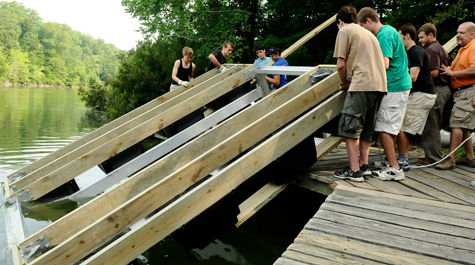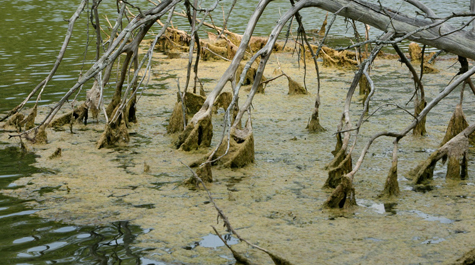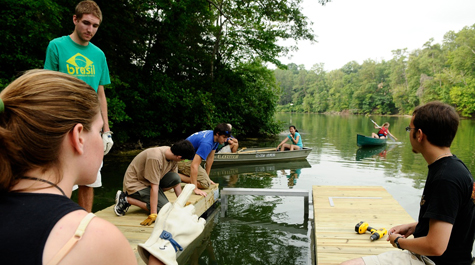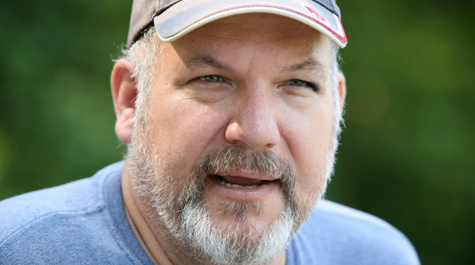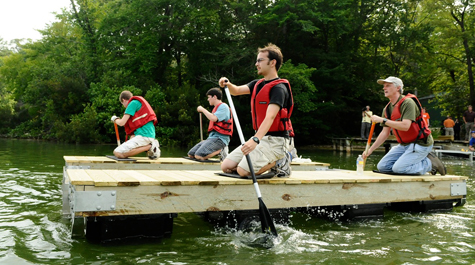'A 40-foot hole in the water'
A team of William & Mary researchers is putting the final touches on the assembly of an experimental algae-growth flume in the middle of the College’s Lake Matoaka.
The Matoaka flume is the latest initiative of the Chesapeake Algae Project, or ChAP. The goal of ChAP is to produce biofuels from oil extracted from wild, naturally growing algae. With the aim of producing alternatives to petroleum-based fuels from excess aquatic algal growth, ChAP is a research project that has been characterized as an “environmental twofer.”
{{youtube:medium|AO9yo0QHsPM, ChAPalgae}}
Based at William & Mary and its Virginia Institute of Marine Science, ChAP has received $3 million in start-up money from Statoil, the Norwegian energy company. In addition to Statoil, the ChAP initiative involves other corporate partners including HydroMentia and the Williamsburg energy consulting firm Blackrock Energy. ChAP also includes researchers from the Smithsonian Institution, University of Maryland and the University of Arkansas, as well as from several departments at William & Mary and VIMS.
The Matoaka flume will allow the researchers to figure out how to optimize algae growth conditions, explained William E. Cooke, professor of physics at William & Mary. The flume itself is essentially what research scientist Karl Kuschner calls a “40-foot hole in the water.” It’s basically a floating trough with set of pumps at one end.
“The pumps let us determine the optimum current flow across the algae. They’re a temporary experimental control mechanism,” Kuschner said. “In an actual production situation, the flow will be created by tidal currents, rather than a pump.”
Algae will grow naturally on substrate screens positioned in the flume, Cooke said. The flume is outfitted with an array of scientific instruments to allow researchers to track a number of factors, such as nutrient reduction in the water and the rate and extent of algal growth.
“Usually, algae growth is measured by harvesting and drying,” Cooke said, “but we will use photometric methods to determine the growth before we harvest. That way we can determine the best time to harvest and the best method for harvesting.”
Just after the Fourth of July weekend ended, a student-faculty construction team manhandled sections of the flume into the water at the Matoaka Boathouse dock. The week before, the team sweated in temperatures hovering around the century mark to assemble the floating platforms from which researchers will service the flume.
Once all the pieces were launched, a flotilla of boats and canoes paddled by faculty and students towed each piece from the boathouse to the flume’s assembly and deployment site off the coast of William & Mary’s Keck Environmental Field Laboratory.
Algae offer promise as biofuels based on their lipid—or oil—content. Most algal fuel research projects are based on the cultivation of a single species of algae that has a high lipid content. But Dennis Manos, William & Mary’s vice provost for research, notes that ChAP differs from other algal biofuel initiatives in using wild, naturally growing algal species as a basis for various energy products.
The wild-algae approach has a number of benefits over monoculture approaches. For instance, Manos points out that wild algae make up for their lower lipid content by being more robust, fast-growing and plentiful: “If I can grow three grams of something that’s half as efficient in the time it takes you to grow one gram of something that’s perfectly efficient, I still win.”
Cooke notes that the ChAP philosophy has implications for fuel-production issues as well as environmental concerns.
“Whatever algae we grow will give us two major benefits,” he said. “First, the algae remove excess nutrients from the water, and since we harvest it, the nutrients are truly removed. If left alone, the algae would die and sink where they would be decomposed by bacteria which would also remove the oxygen from the water, creating a ‘dead zone’.”
Secondly, he said, the ChAP approach embraces a more varied set of potential biofuel products. The harvested algae can be converted into a variety of fuels—biodiesel if there are enough lipids, otherwise the algae can be fermented into an alcohol such as ethanol or butanol.
The Matoaka flume is ChAP’s first freshwater experiment. Throughout the summer and fall, ChAP personnel will be working to optimize the algal growth by tweaking the components of the flume. Cooke said they will adjust the current flow using the pumps, experiment with different kinds and placements of substrate screens and figure out the best way to harvest.
The launch of the Matoaka experiment garnered a fair amount of media interest, including mentions in The Washington Post blog and the Huffington Post. However, ChAP is not a new endeavor. For more than a year, team members have been monitoring brackish water algal growth at a floway installed at the VIMS Gloucester Point campus.
ChAP is planning to deploy a flume in the York River in August. With the launching of the York River experiment, Cooke said that ChAP will be getting very close to a production-level algal growth apparatus.















